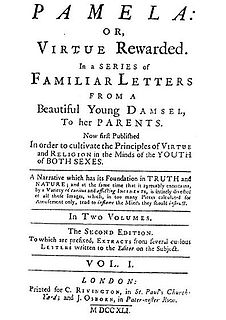
An epistolary novel is a novel written as a series of documents. The usual form is letters, although diary entries, newspaper clippings and other documents are sometimes used, as are electronic documents such as recordings and radio, blogs, and e-mails. The word epistolary is derived from Latin from the Greek word ἐπιστολή epistolē, meaning a letter. In German, this type of novel is known as a Briefroman.

The Picture of Dorian Gray is a philosophical novel by Oscar Wilde. A shorter novella-length version was published in the July 1890 issue of the American periodical Lippincott's Monthly Magazine. Wilde then expanded that text into a novel published as a book in April 1891.
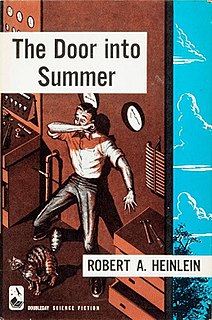
The Door into Summer is a science fiction novel by American writer Robert A. Heinlein, originally serialized in The Magazine of Fantasy & Science Fiction. It was published in hardcover in 1957.
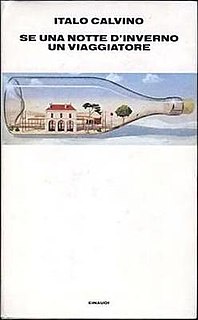
If on a winter's night a traveler is a 1979 novel by the Italian writer Italo Calvino. The postmodernist narrative, in the form of a frame story, is about the reader trying to read a book called If on a winter's night a traveler. Each chapter is divided into two sections. The first section of each chapter is in second person, and describes the process the reader goes through to attempt to read the next chapter of the book he or she is reading. The second half is the first part of a new book that the reader ("you") finds. The second half is always about something different from the previous ones. The book was published in an English translation by William Weaver in 1981.

Go Ask Alice is a 1971 book about a teenage girl who develops a drug addiction at age 15 and runs away from home on a journey of self-destructive escapism. Attributed to "Anonymous", the book is in diary form, and was originally presented as being the edited "real diary" of the unnamed teenage protagonist. Questions about the book's authenticity and true authorship began to arise in the late 1970s, and Beatrice Sparks is now generally viewed as the author of the found manuscript-styled fictional document. A therapist, Sparks went on to write numerous other books purporting to be real diaries of troubled teenagers. Some sources have also named Linda Glovach as a co-author of the book. Nevertheless, its popularity has endured, and as of 2014 it had remained continuously in print since its publication over four decades earlier.
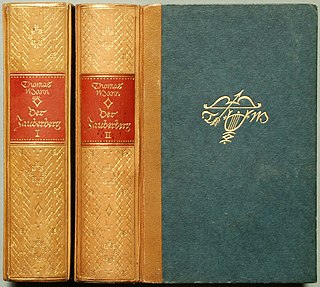
The Magic Mountain is a novel by Thomas Mann, first published in German in November 1924. It is widely considered to be one of the most influential works of twentieth-century German literature.
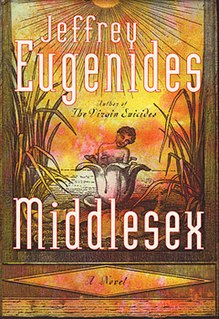
Middlesex is a Pulitzer Prize-winning novel by Jeffrey Eugenides published in 2002. The book is a bestseller, with more than four million copies sold since its publication. Its characters and events are loosely based on aspects of Eugenides' life and observations of his Greek heritage. It is not an autobiography; unlike the protagonist, Eugenides is not intersex. The author decided to write Middlesex after reading the 1980 memoir Herculine Barbin and was dissatisfied with its discussion of intersex anatomy and emotions.
Young adult fiction (YA) is a category of fiction written for readers from 12 to 18 years of age. While the genre is targeted at adolescents, approximately half of YA readers are adults.
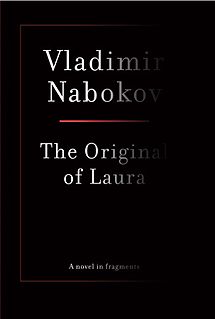
The Original of Laura is an incomplete novel by Vladimir Nabokov, which he was writing at the time of his death in 1977. It was published by Nabokov’s son Dmitri Nabokov in 2009, despite the author’s request that the work be destroyed upon his death.

Vivian Grey is Benjamin Disraeli's first novel, published by Henry Colburn in 1826. Originally published anonymously, ostensibly by a so-called "man of fashion", part 1 caused a considerable sensation in London society. Contemporary reviewers, suspicious of the numerous solecisms contained within the text, eventually identified the young Disraeli as the author. Disraeli continued the tale in a second volume, also of 1826, and three subsequent volumes in 1827. The form in which Vivian Grey is published now is the revised 1853 edition, which was severely expurgated and, according to critic Wendy Burton, lost much of the charm and freshness of the 1826 edition. The book is a frequent touchstone for discussions of Disraeli's political and literary career.

Until I Find You (2005) is the 11th published novel by John Irving. The novel was originally written in first person and only changed 10 months before publication. After realizing that so much of the material—childhood sexual abuse and a long-lost father who eventually ends up in a mental institution—was too close to his own experiences, Irving postponed publication of the novel while he rewrote it entirely in third person.

Darkfall is the first novel in the Legendsong Saga series by Australian author Isobelle Carmody. Carmody wrote the first drafts for all three books in the trilogy concurrently whilst living in Prague. It was published by Viking Books in Australia in 1997 and shortlisted for ‘Best Fantasy Novel’ at the 1998 Aurealis Awards and for ‘Australian Long Fiction’ at the 1998 Ditmar Awards.

Viña Delmar was an American short story writer, novelist, playwright, and screenwriter who worked from the 1920s to the 1970s. She rose to fame in the late 1920s with the publication of her suggestively titled novel, Bad Girl, which became a bestseller in 1928. Delmar also wrote the screenplay to the screwball comedy, The Awful Truth, for which she received an Academy Award nomination in 1937.
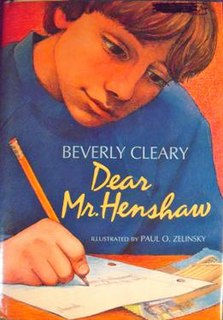
Dear Mr. Henshaw is a juvenile epistolary novel by Beverly Cleary and illustrator Paul O. Zelinsky that was awarded the Newbery Medal in 1984. Based on a 2007 online poll, the National Education Association listed the book as one of its "Teachers' Top 100 Books for Children".
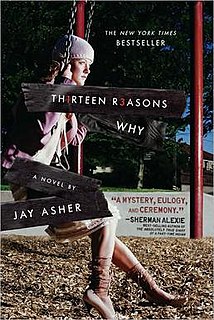
Thirteen Reasons Why is a young adult novel written by Jay Asher in 2007, that follows the story of Hannah Baker, a high school freshman, and the thirteen reasons why she commits suicide. Following her death, Hannah leaves behind a series of 7 double-sided cassette tapes detailing the 13 specific people and events that she blames for her demise. Two weeks after her death these cassette tapes are mailed out with directions to pass the tapes on to the next person on the tape. Hannah's life story is conveyed through these tapes, which are narrated by Hannah herself, and through the point of view of Clay, her classmate and the ninth person to receive the tapes. The inspiration behind the main character, Hannah Baker, comes from author Jay Asher's close relative who attempted suicide.

Half Bad is a 2014 young adult fantasy novel written by English debut author Sally Green. It is notable for its use of second person narrative as part of a wider first person narrative. On 3 March 2014, it set the Guinness World Record as the 'Most Translated Book by a Debut Author, Pre-publication', having sold in 45 languages prior to its UK publication by Penguin books.

The Rosie Project is a 2013 Australian novel by Australian novelist Graeme Simsion. The novel centres on genetics professor Don Tillman, who struggles to have a serious relationship with women. With a friend's help, he devises a questionnaire to assess the suitability of female partners. His plans are set off course when he meets Rosie, who does not fit many of Tillman's criteria, but becomes a big part of his life. The work was first published on 30 January 2013 in Australia by Text Publishing and the rights have since been sold in over 40 other countries. International sales are in excess of 3.5 million copies and the book was named Book of the Year for 2014 by the Australian Book Industry Association. In the United States the novel was published through Simon & Schuster and in the United Kingdom through Penguin Books.

Ginny Field is a fictional character in the Friday the 13th series. She first appears in Friday the 13th Part 2 (1981) as an aspiring child psychologist that encounters the sack-wearing serial killer Jason Voorhees. In this film, Amy Steel portrays her—who reprises the role in the fan film Jason Rising (2021) in a voice role.

The Testaments is a 2019 novel by Margaret Atwood. It is a sequel to The Handmaid's Tale (1985). The novel is set 15 years after the events of The Handmaid's Tale. It is narrated by: Aunt Lydia, a character from the previous novel; Agnes, a young woman living in Gilead; and Daisy, a young woman living in Canada.
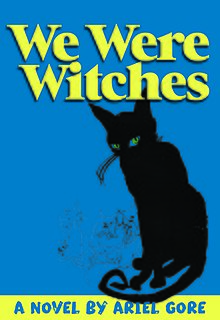
We Were Witches is a 2017 novel by Ariel Gore. It is a first-person narrative of a fictionalized version of the author, of her life as a teen mom and budding feminist, from the birth of her daughter when she was 18 years old, to her graduation from Mills College.



















